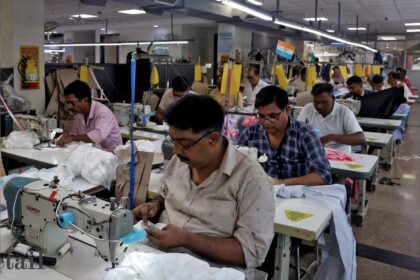
US President Donald Trump‘s steep new tariffs on Indian imports, totalling 50%, threaten India’s exports of several products, especially the thriving textile sector. At Tiruppur, Tamil Nadu’s knitwear hub, exporters are worried about the impact. Tiruppur Exporters’ Association (TEA) president K M Subramanian said the region’s total annual exports stand at around Rs 45,000 crore, with the US accounting for Rs 12,000 crore or 30 per cent of the total. “We expect 50 per cent of business to the US — worth about Rs 6,000 crore — to be impacted,” he told PTI. Industry members said some exporters have already stopped production, while others are exploring alternatives.“Right now, those catering to the US have halted production. It will severely impact us. We are adopting a wait-and-watch strategy for the next two weeks,” Subramanian said. Orders already received have been put on hold “as per buyers’ decision” and stock is being held, he added. Trump’s steep tariffs jeopardise the future of India’s textile industry as production might shift in future to low-tariffed countries and India may lose its export share to those countries.
But Trump is not the first to impose high tariffs to weaken India’s export economy. Much before him, the British colonial regime specifically targeted India’s textile industry with steep tariffs to kill its export competitiveness.
How the British killed India’s textile industry
India, prior to British colonisation, was one of the leading producers and exporters of fine textiles, particularly cotton and silk. Cities like Dhaka, Surat and Murshidabad were renowned for their skilled artisans and quality fabrics. However, with the advent of British colonialism, this flourishing industry experienced a steep decline. The causes of this downfall lie not just in internal inefficiencies but also in deliberate colonial policies that prioritised British economic interests over indigenous prosperity.
Indian textile had a big market across the world before the British regime started weakening it. It was said that a whole sheet of Dhaka muslin could pass through a ring so fine it was. An Arab merchant who visited India in medieval times, wrote, “There is a stuff made in his country which is not to be found elsewhere; so fine and delicate is this material that a dress made of it may be passed through a signet-ring. It is made of cotton, and we have seen a piece of it.”
The chief reason behind the decline of India’s textile exports is considered to be the Industrial Revolution which brought machine-made cloth in Europe which could not match the quality of Indian cloth but was cheaper and could be made in less time. However, another key reason was the British efforts to destroy indigenous industry and discourage exports with taxes and tariffs.
During the Industrial Revolution, Britain was experiencing unprecedented growth in mechanised textile production. The demand for raw materials, especially cotton, was insatiable. By imposing restrictions on Indian textiles, the British aimed to secure a steady supply of raw cotton from India. This allowed British manufacturers to capitalize on the raw material, ultimately strengthening Britain’s dominance in the global textile trade which was hitherto dominated by India.
The British administration systematically dismantled India’s traditional textile industry. Indian artisans, who once catered to global demand, faced restrictive export duties that made it difficult for their products to remain competitive internationally. At the same time, British-manufactured textiles were imported into India without any comparable duties, giving them a price advantage in domestic markets. This dual pressure led to a significant drop in demand for Indian-made textiles, both at home and abroad, eventually crippling the traditional craft-based economy.
The British tariffs on Indian textiles
A key strategy of the British regime was to flood the Indian market with British-manufactured textile almost duty-free, while imposing steep tariffs — 70% to 80% — on India-Made textiles that entered England. Will Durant, an American historian and philosopher, narrated this phenomenon in his book “The Case for India” which was published in 1930.
“The Directors of the East India Company gave orders that the production of raw silk should be encouraged and the manufacture of silk fabrics discouraged; that silk-winders should be compelled to work in the Company’s factories, and be prohibited, under severe penalties, from working outside,” Durant wrote. “Parliament discussed ways and means of replacing Hindu by British industries. A tariff of 70-80% was placed upon Hindu textiles imported into free- trade England, while India was compelled, by foreign control of her government, to admit English textiles almost duty free. Lest Indian industries should nevertheless continue somehow to exist, an excise tax was placed on the manufacture of cotton goods in India.”
Durant cites a British historian who said India being dependent could not impose a counter tariff of its own on British-made textiles: “As a British historian puts it: It is a melancholy instance of the wrong done to India by the country on which she has become dependent. Had India been independent, she would have retaliated, would have imposed prohibitive duties upon British goods, and would thus have preserved her own productive industry from annihilation. This act of self-defense was not permitted her; she was at the mercy of the stranger. British goods were forced upon her without paying any duty, and the foreign manufacturer employed the arm of political injustice to keep down and ultimately strangle a competitor with whom he could not have contended on equal terms.”
He cites another British writer who said how Britain used tariffs in the guise of free trade to impoverish India. “And another Englishman wrote: We have done everything possible to impoverish still further the miserable beings subject to the cruel selfishness of English commerce. Under the pretense of free trade, England has compelled the Hindus to receive the products of the steam-looms of Lancashire, Yorkshire, Glasgow, etc., at merely nominal duties; while the hand wrought manufactures of Bengal and Behar, beautiful in fabric and durable in wear, have heavy and almost prohibitive duties imposed on their importation into England. The result was that Manchester and Paisley flourished, and Indian industries declined; a country well on the way to prosperity was forcibly arrested in its development, and compelled to be only a rural hinterland for industrial England,” Durant wrote.
The British had also banned some Indian textiles by passing a law. The Calico Act of 1721 was passed by the British Parliament to protect the British wool and silk industries from the popularity and affordability of Indian cotton textiles. The act banned the wearing and use of printed cotton fabrics in England.







